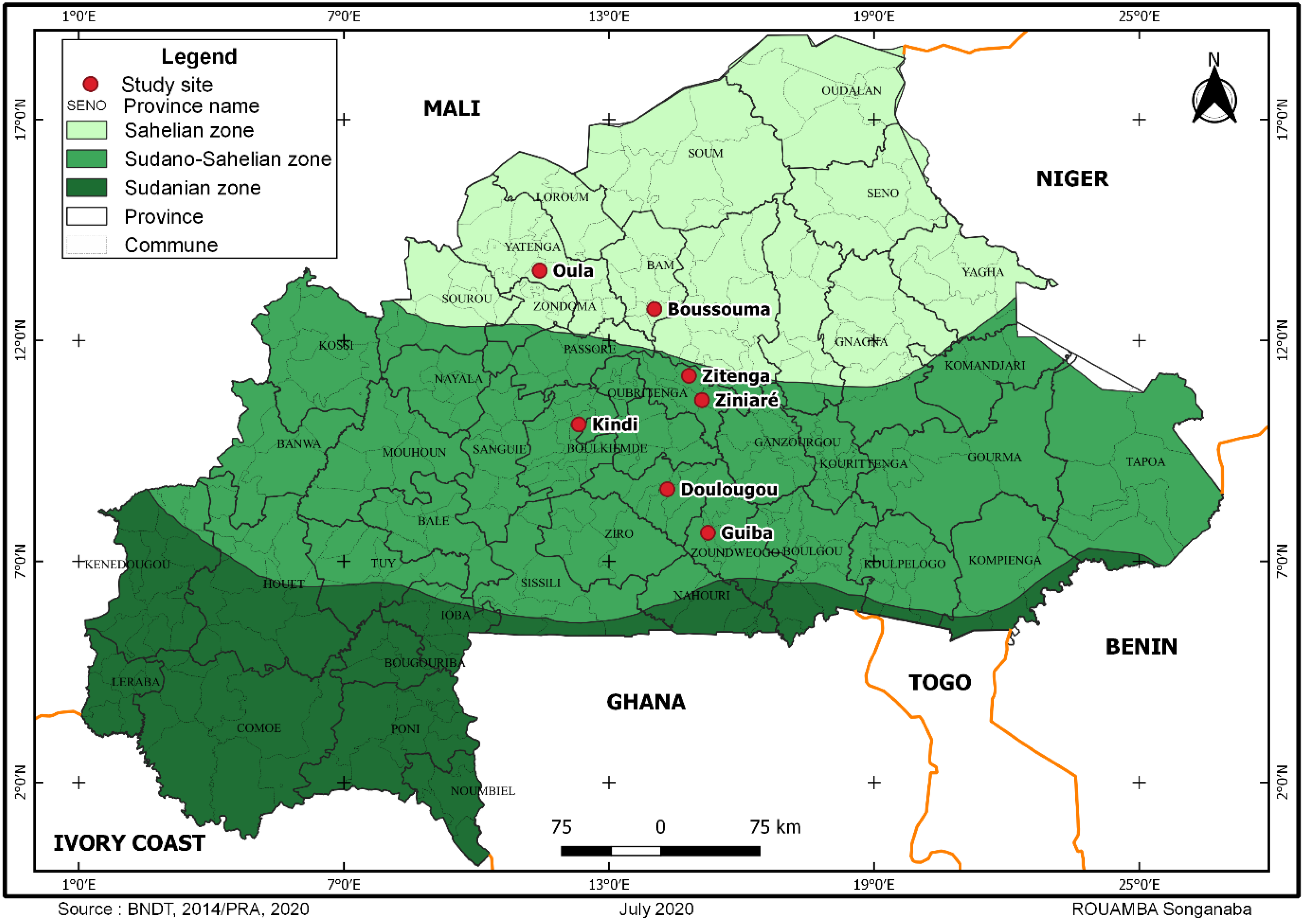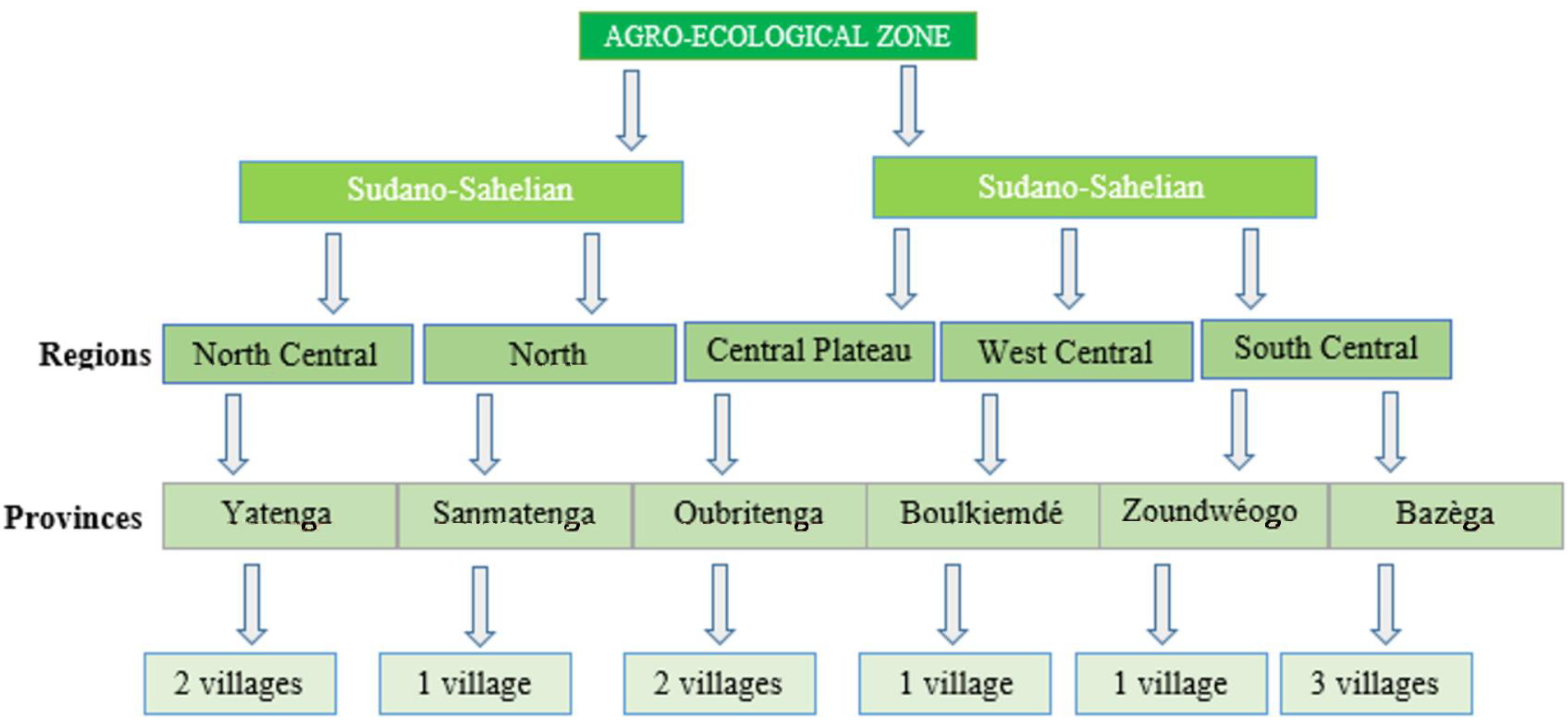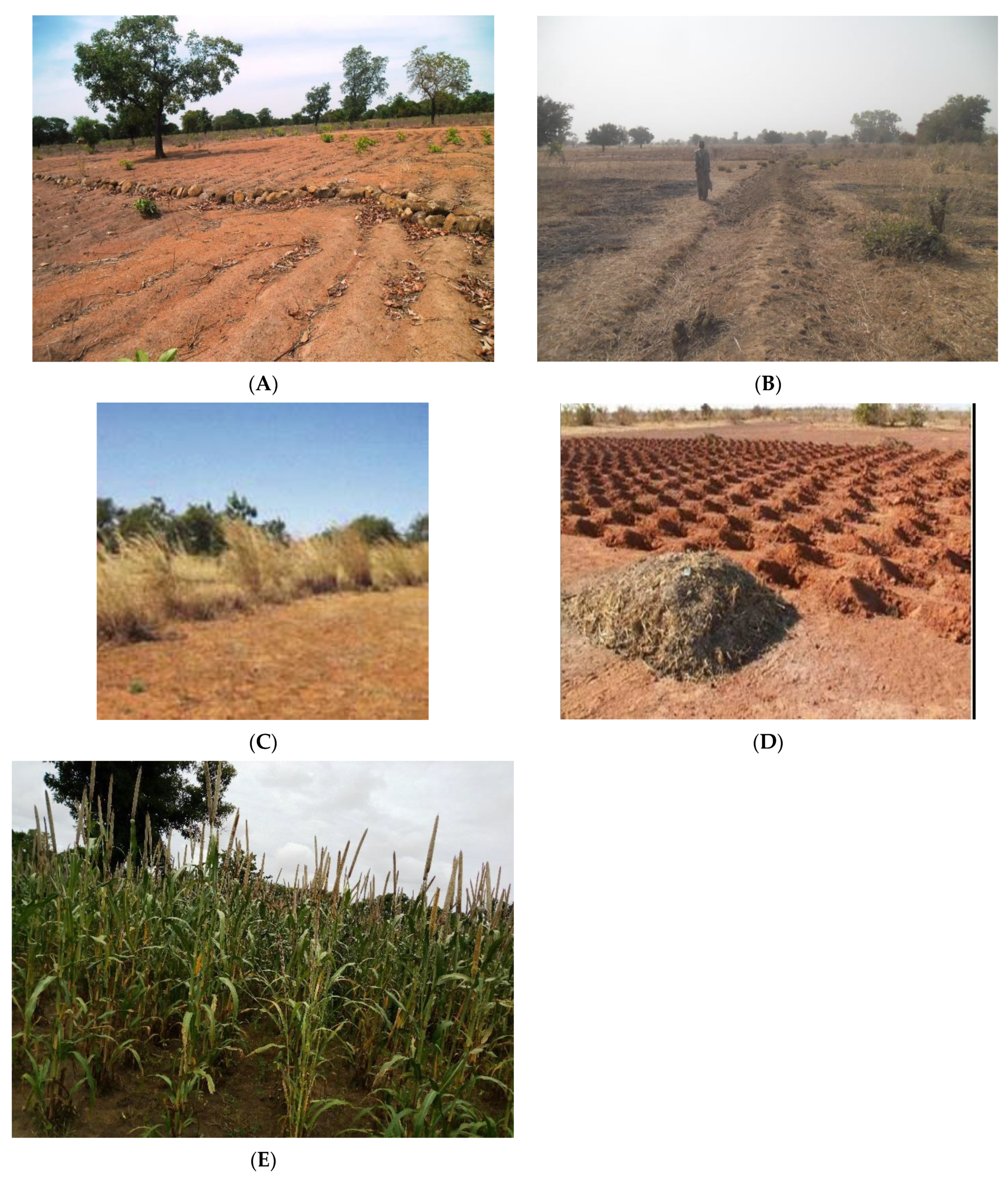Constraints to Pearl Millet (Pennisetum glaucum) Production and Farmers’ Approaches to Striga hermonthica Management in Burkina Faso
Abstract
1. Introduction
2. Materials and Methods
2.1. Description of the Study Sites
2.2. Sampling Method
2.3. Data Collection and Analyses
3. Results
3.1. Sociodemographic Description of Respondent Farmers
3.2. Main Socio-Economic Activities in the Study Provinces
Income Sources
3.3. Pearl Millet Varieties Grown in the Study Areas
3.4. Status of Pearl Millet Production
3.5. Constraints to Pearl Millet Production in Burkina Faso
3.6. S. Hermonthica Infestation and Control Strategies
4. Discussion
4.1. Social and Demographical Description of Respondent Farmers
4.2. Main Socio-Economic Activities in the Study Provinces
Income Sources
4.3. Pearl Millet Varieties Grown in the Study Areas
4.4. Pearl Millet Production
4.5. Constraints to Pearl Millet Production
4.6. S. hermonthica Infestation and Control Strategies
5. Conclusions
Author Contributions
Funding
Institutional Review Board Statement
Informed Consent Statement
Data Availability Statement
Conflicts of Interest
References
- Rao Venkata, N.; Rao, K.; Gupta, S.; Mazvimavi, K.; Kumara Charyulu, D.; Nagaraj, N.; Singh, R.; Singh, S.; Singh, S. Impact of ICRISAT Pearl Millet Hybrid Parents Research Consortium (PMHPRC) on the Livelihoods of Farmers in India; Research Report No 75; ICRISAT: Patancheru, India, 2018. [Google Scholar]
- Shah, I.A.; Shah, S.; Zahir, S.; Saeedur, R.; Muhammad, N. Characterization of pearl millet germplasm for various morphological and fodder yield parameters. Pak. J. Bot. 2012, 44, 273–279. [Google Scholar]
- FAOSTAT. FAOSTAT Online Database 2020; FAO: Rome, Italy, 2020. [Google Scholar]
- Drabo, I.; Zangre, R.G.; Danquah, E.Y.; Ofori, K.; Witcombe, J.R.; Hash, C.T. Identifying famers’ preferences and constraints to Pearl Millet productionin the Sahel and North-Sudan zones of Burkina Faso. Exp. Agric. 2019, 55, 765–775. [Google Scholar] [CrossRef]
- Bationo, A.; Ntare, B.R. Rotation and nitrogen fertiliser effects on pearl millet, cowpea, and groundnut yield and soil chemical properties in a sandy soil in the semi-arid tropics, West Africa. J. Agric. Sci. 2000, 134, 277–284. [Google Scholar] [CrossRef]
- Emechebe, A.M.; Ellis-Jones, J.; Schulz, S.; Chikoye, D.; Douthwaite, B.; Kureh, I.; Tarawali, G.; Hussaini, M.A.; Kormawa, P.; Sanni, A. Farmers’perception of the Striga problem and its control in northern Nigeria. Exp. Agric. 2004, 40, 215–232. [Google Scholar] [CrossRef]
- Boussim, I.J.; Yonli, D.; Guinko, S.; Sallé, G. Etat d’infestation, connaissance endogène et approche systématique des espèces du genre Striga au Burkina Faso. Int. J. Biol. Chem. Sci. 2011, 5, 1374–1386. [Google Scholar] [CrossRef]
- Zombré, P.N.; Nikiéma, S. Importance et effet de Striga hermontheca (Del.) Benth sur la production du sorgho en zone Nord Soudanienne du Burkina Faso: Cas de Linonghin. Rev. Réseau L’amélioration Product. Agric. Milieu Arid. 1992, 4, 103–112. [Google Scholar]
- Traoré, H.; Yonli, D. Striga et autres adventices: Perception paysanne et inventaire des méthodes endogènes de lutte dans l’Est du Burkina Faso. Sci. Nat. Agron. 2001, 25, 46–59. [Google Scholar]
- Mrema, E.; Shimelis, H.; Laing, M.; Bucheyeki, T. Screening of sorghum genotypes for resistance to Striga hermonthica and S. asiatica and compatibility with Fusarium oxysporum f. sp. strigae. Acta Agric. Scand. Sect. B Soil Plant Sci. 2017, 67, 395–404. [Google Scholar]
- Chambers, R. Rural Apprasial: Rapid, Relaxed and Participatory; IDS Discussion Paper 311; IDS1992; Institute of Development Studies: Brighton, UK, 1992. [Google Scholar]
- Negash, Z.; Nega, F.; Gebregziabher, K.; Ejigu, A.; Berhanu, M.; Nyssen, J.N.; Babulo, B.; Deckers, J.; Tollens, E. Manual for Participatory Rural Appraisal (PRA) in Villages of Tigray; Faculty of Business and Economics, Mekelle University: Mekelle, Ethiopia, 2006. [Google Scholar]
- FAO. Participatory Rural Appraisal (PRA) Manual; FAO: Rome, Italy, 2009; p. 56. [Google Scholar]
- Chambers, R. Participatory rural appraisal (PRA): Challenges, potentials and paradigm. World Dev. 1994, 22, 1437–1454. [Google Scholar] [CrossRef]
- DeVries, J.; Toenniessen, G.H. Securing the Harvest: Biotechnology, Breeding, and Seed Systems for African Crops; CABI: Wallingford, UK, 2001. [Google Scholar]
- Omanya, G.; Weltzien, E.; Sogodogo, D.; Sanogo, M.; Hanssens, N.; Guero, Y.; Zangré, R. Participatory varietal selection with improved pearl millet in West Africa. Exp. Agric. 2007, 43, 5–19. [Google Scholar] [CrossRef][Green Version]
- Dawud, M.A.; Angarawai, I.I.; Tongoona, P.B.; Ofori, K.; Eleblu, J.S.; Ifie, B. Farmers’ Production Constraints, Knowledge of Striga and Preferred Traits of Pearl Millet in Jigawa State, Nigeria. Glob. J. Sci. Front. Res. D Agric. Vet. 2017, 17, 1–7. [Google Scholar]
- Pieyns, S.A. Amélioration de la Connaissance et de la Gestion des Eaux au Burkina Faso; World Bank: Washington, DC, USA, 2017; p. 104. [Google Scholar]
- Traoré, K.; Toé, A. Capitalisation des Initiatives sur les Bonnes Pratiques Agricoles au Burkina Faso; MAHRH/DVRD: Ouagadougou, Burkina Faso, 2008. [Google Scholar]
- MAAH. Annuaire des Statistiques Agricoles 2019 (MAAH, Burkina Faso); DGESS: Ouagadougou, Burkina Faso, 2020; p. 434. [Google Scholar]
- FAOSTAT. FAOSTAT Online Database 2021; FAO: Rome, Italy, 2021. [Google Scholar]
- Ceccarelli, S.; Guimarães, E.P.; Weltzien, E. Plant Breeding and Farmer Participation; Food and Agriculture Organization of the United Nations: Rome, Italy, 2009; p. 685. [Google Scholar]
- BBerchie, J.; Dapaah, H.A.; Dankyi, A.; Plahar, W.; Quartey, F.N.; Haleegoah, J.; Agyei, J.A.; Addo, J. Practices and constraints in Bambara groundnuts production, marketing and consumption in the Brong Ahafo and Upper-East Regions of Ghana. J. Agron. 2010, 9, 111–118. [Google Scholar] [CrossRef][Green Version]
- Ajeigbe, H.A.; Goodrich, C.G.; Ntare, B.R.; Weltzien, E.; Ndjeunga, J. Involving women in research for economic growth through agricultural technologies and practices: ICRISAT’s initiatives in sub-Saharan Africa. Secheresse 2013, 24, 359–366. [Google Scholar] [CrossRef]
- Ellis, F. Peasant Economics: Farm Households in Agrarian Development; Cambridge University Press: Cambridge, UK, 1993; Volume 23. [Google Scholar]
- Mrema, E.; Shimelis, H.; Laing, M.; Bucheyeki, T. Farmers’ perceptions of sorghum production constraints and Striga control practices in semi-arid areas of Tanzania. Int. J. Pest Manag. 2016, 63, 146–156. [Google Scholar] [CrossRef]
- Fonta, C.L.; Yameogo, T.B.; Tinto, H.; Van Huysen, T.; Natama, H.M.; Compaore, A.; Fonta, W.M. Decomposing multidimensional child poverty and its drivers in the Mouhoun region of Burkina Faso, West Africa. BMC Public Health 2020, 20, 149. [Google Scholar] [CrossRef] [PubMed]
- Mwangi, E.; Patrick, E. Land Rights for African Development: From Knowledge to Action; CGIAR CAPRi: Washington, DC, USA, 2006. [Google Scholar]
- Rahman, M.Z.; Yamao, M. Farmers’ Attitudes towards Participatory Resource Management for Sustainable Farming Development: A Study from Bangladesh; Hiroshima University: Hiroshima, Japan, 2006; pp. 632–639. [Google Scholar]
- PNDES. Plan National de Développement Economique et Social (PNDES) 2016–2020; PNDES: Burkina Faso, South Africa, 2016; p. 97. [Google Scholar]
- Sorgho, Z. Économie Agricole du Burkina Faso: Un Potentiel de Développement; Éditions Baudelaire: Lyon, France, 2010; p. 163. [Google Scholar]
- Boubacar, I. The Effects of Drought on Crop Yields and Yield Variability in Sahel; University of Wisconsin: Stout, WI, USA, 2010. [Google Scholar]
- Lubadde, G.; Tongoona, P.; Derera, J.; Sibiya, J. Production determinants of the pearl millet cropping system in Uganda and implications to productivity. J. Agric. Sci. 2016, 8, 97–111. [Google Scholar] [CrossRef]
- Bishaw, Z. Wheat and Barley seed Systems in Ethiopia and Syria. Ph.D. Thesis, Wageningen University, Wageningen, The Netherlands, 2004; p. 383. [Google Scholar]
- Nagayets, O. Small farms: Current status and key trends. In Proceedings of the Research Workshop Wye College, Wye, UK, 26–29 June 2005; p. 14. [Google Scholar]
- Fisher, M.; Kandiwa, V. Can agricultural input subsidies reduce the gender gap in modern maize adoption? Evidence from Malawi. Food Policy 2014, 45, 101–111. [Google Scholar] [CrossRef]
- Yoneyama, K.; Awad, A.A.; Xie, X.; Takeuchi, Y. Strigolactones as germination stimulants for root parasitic plants. Plant Cell Physiol. 2010, 51, 1095–1103. [Google Scholar] [CrossRef] [PubMed]
- Ouedraogo, N.; Sanou, J.; Kam, H.; Traore, H.; Adam, M.; Gracen, V.; Danquah, E.Y. Farmers’ perception on impact of drought and their preference for sorghum cultivars in Burkina Faso. Agric. Sci. Res. J. 2017, 7, 277–284. [Google Scholar]
- Ghimire, R.; Huang, W.-C.; Shrestha, R.B. Factors affecting adoption of improved rice varieties among rural farm households in Central Nepal. Rice Sci. 2015, 22, 35–43. [Google Scholar] [CrossRef]
- Cotter, M.; de la Pena-Lavander, R.; Sauerborn, J. Understanding the present distribution of the parasitic weed Striga hermonthica and predicting its potential future geographic distribution in the light of climate change. In Proceedings of the 25th German Conference on Weed Biology and Weed Control, Braunschweig, Germany, 13–15 March 2012; pp. 630–636. [Google Scholar]




| Variable | Class | Regions | Mean | df | Chi-Square | p-Value | ||
|---|---|---|---|---|---|---|---|---|
| North Central | South Central | North | ||||||
| Gender | Male | 43 | 65 | 36 | 48 | 2 | 18.349 | 0.000 |
| Female | 57 | 35 | 64 | 52 | ||||
| Family size | 1–10 | 49 | 62 | 43 | 51.3 | 4 | 65.370 | 0.183 |
| 11–20 | 45 | 32 | 42 | 39.7 | ||||
| >20 | 6 | 6 | 15 | 9 | ||||
| Age (years) | <30 | 16 | 10 | 12 | 12.7 | 4 | 136.094 | 0.060 |
| 30–50 | 43 | 61 | 55 | 53 | ||||
| >50 | 41 | 29 | 33 | 34.3 | ||||
| Marital status | Married | 97 | 85 | 94 | 92 | 4 | 11.048 | 0.026 |
| Single | 0 | 3 | 1 | 1.3 | ||||
| Widowed | 3 | 12 | 5 | 6.7 | ||||
| Education level | Literate | 96 | 88 | 86 | 90 | 6 | 11.242 | 0.081 |
| Primary school | 3 | 11 | 11 | 8.3 | ||||
| Secondary school | 1 | 0 | 3 | 1.3 | ||||
| Graduate | 0 | 1 | 0 | 0.4 | ||||
| Income Source | Regions | Mean | df | Chi-Square | p-Value | ||
|---|---|---|---|---|---|---|---|
| North Central | South Central | North | |||||
| Crop production | 43 | 7 | 60 | 36.7 | 16 | 2.326 | 0.000 |
| Livestock production | 4 | 41 | 11 | 18.7 | |||
| Crop and livestock production | 49 | 0 | 14 | 21.0 | |||
| Tuckshop | 3 | 45 | 5 | 17.7 | |||
| Crop production and tuckshop | 0 | 0 | 8 | 2.7 | |||
| Craftmanship | 0 | 3 | 1 | 1.3 | |||
| Gardening | 0 | 3 | 1 | 1.3 | |||
| Livestock production and tuckshop | 0 | 1 | 0 | 0.3 | |||
| Processing of crop products | 1 | 0 | 0 | 0.3 | |||
| Crop | Varieties | Regions | Mean | df | Chi-Square | p-Value | ||
|---|---|---|---|---|---|---|---|---|
| North Central | South Central | North | ||||||
| Pearl millet | Local | 6 | 80 | 97 | 61 | 2 | 2876 | 0.000 |
| Improved | 93 | 0 | 3 | 32 | ||||
| Sorghum | Local | 14 | 79 | 43 | 45.3 | 2 | 106.840 | 0.000 |
| Improved | 25 | 0 | 3 | 9.3 | ||||
| Cowpea | Local | 5 | 56 | 40 | 33.7 | 2 | 169.769 | 0.000 |
| Improved | 81 | 12 | 6 | 33 | ||||
| Maize | Local | 0 | 50 | 23 | 24.3 | 2 | 166.425 | 0.000 |
| Improved | 1 | 37 | 6 | 14.7 | ||||
| Groundnut | Local | 4 | 30 | 44 | 26 | 2 | 101.267 | 0.000 |
| Improved | 34 | 0 | 0 | 11.3 | ||||
| Sesame | Local | 0 | 2 | 6 | 2.7 | 2 | 13.090 | 0.011 |
| Improved | 3 | 0 | 0 | 1 | ||||
| Bambara nut | Local | 4 | 1 | 4 | 3 | 2 | 72.177 | 0.000 |
| Improved | 31 | 0 | 0 | 10.3 | ||||
| Rice | Local | 0 | 5 | 0 | 16.7 | 2 | 18.557 | 0.001 |
| Improved | 0 | 4 | 0 | 1.3 | ||||
| Year | Regions | Production Areas (ha) and Number of Respondents | df | Chi-Square | p-Value | ||||||
|---|---|---|---|---|---|---|---|---|---|---|---|
| [0–1] | [1–2] | [2–3] | [3–4] | [4–5] | [5–6] | [6–7] | |||||
| 2015 | South Central | 26 | 10 | 0 | 0 | 0 | 0 | 0 | 12 | 119.895 | 0.000 |
| North | 15 | 43 | 25 | 8 | 1 | 1 | 0 | ||||
| North Central | 10 | 27 | 24 | 19 | 3 | 0 | 1 | ||||
| Total | 51 | 80 | 49 | 27 | 4 | 1 | 1 | ||||
| 2016 | South Central | 23 | 13 | 1 | 0 | 0 | 0 | 0 | 12 | 102.140 | 0.000 |
| North | 14 | 42 | 26 | 8 | 1 | 1 | 0 | ||||
| North Central | 11 | 27 | 25 | 20 | 2 | 0 | 1 | ||||
| Total | 48 | 82 | 52 | 28 | 3 | 1 | 1 | ||||
| 2017 | South Central | 27 | 25 | 4 | 1 | 0 | 0 | 0 | 12 | 91.024 | 0.000 |
| North | 16 | 44 | 28 | 8 | 1 | 1 | 0 | ||||
| North Central | 11 | 28 | 29 | 19 | 3 | 0 | 1 | ||||
| Total | 54 | 97 | 61 | 28 | 4 | 1 | 1 | ||||
| 2018 | South Central | 31 | 29 | 3 | 1 | 0 | 0 | 0 | 12 | 101.618 | 0.000 |
| North | 16 | 46 | 28 | 8 | 1 | 1 | 0 | ||||
| North Central | 12 | 30 | 29 | 21 | 2 | 0 | 1 | ||||
| Total | 59 | 105 | 60 | 30 | 3 | 1 | 1 | ||||
| 2019 | South Central | 49 | 26 | 4 | 1 | 0 | 0 | 0 | 12 | 113.365 | 0.000 |
| North | 14 | 48 | 26 | 8 | 1 | 1 | 0 | ||||
| North Central | 14 | 31 | 31 | 20 | 2 | 1 | 1 | ||||
| Total | 77 | 105 | 61 | 29 | 3 | 2 | 1 | ||||
| Yield (kg/ha) | Regions | Mean | df | Chi-Square | p-Value | ||
|---|---|---|---|---|---|---|---|
| North Central | South Central | North | |||||
| [0–500] | 8 | 69 | 15 | 30.7 | 20 | 3.199 | 0.000 |
| [500–1000] | 51 | 5 | 36 | 30.7 | |||
| [1000–1500] | 14 | 0 | 17 | 10.3 | |||
| [1500–2000] | 8 | 0 | 22 | 6.7 | |||
| [2000–2500] | 5 | 0 | 6 | 3.7 | |||
| [2500–3000] | 8 | 0 | 2 | 3.3 | |||
| [3000–3500] | 2 | 0 | 2 | 1.3 | |||
| [3500–4000] | 0 | 0 | 0 | 0 | |||
| [4000–4500] | 0 | 0 | 0 | 0 | |||
| [4500–5000] | 2 | 0 | 0 | 0.7 | |||
| [5000–5500] | 1 | 0 | 0 | 0.3 | |||
| Constraints | Rank | Regions | Mean | df | Chi-Square | p-Value | ||
|---|---|---|---|---|---|---|---|---|
| North Central | South Central | North | ||||||
| Striga hermonthica | 1rst | 26 | 64 | 30 | 40 | 6 | 43.524 | 0.000 |
| 2nd | 48 | 17 | 7 | 24 | ||||
| 3rd | 24 | 15 | 4 | 14.3 | ||||
| 4th | 2 | 1 | 0 | 1 | ||||
| Lack of fertilisers | 1rst | 47 | 16 | 41 | 34.7 | 6 | 41.471 | 0.000 |
| 2nd | 47 | 36 | 32 | 38.3 | ||||
| 3rd | 4 | 15 | 6 | 8.3 | ||||
| 4th | 0 | 8 | 0 | 2.7 | ||||
| Lack of cash | 1rst | 25 | 3 | 16 | 14.7 | 6 | 37.008 | 0.000 |
| 2nd | 3 | 4 | 22 | 9.7 | ||||
| 3rd | 21 | 5 | 15 | 13.7 | ||||
| 4th | 26 | 12 | 5 | 14.3 | ||||
| Drought | 1rst | 2 | 10 | 5 | 5.7 | 6 | 64.906 | 0.000 |
| 2nd | 2 | 33 | 8 | 14.3 | ||||
| 3rd | 26 | 9 | 10 | 15 | ||||
| 4th | 22 | 2 | 1 | 8.3 | ||||
| Lack of improved varieties | 1rst | 0 | 3 | 1 | 1.3 | 6 | 8.876 | 0.181 |
| 2nd | 0 | 4 | 3 | 2.3 | ||||
| 3rd | 2 | 23 | 4 | 9.7 | ||||
| 4th | 3 | 24 | 1 | 9.3 | ||||
| Shortage of labour | 1rst | 0 | 0 | 3 | 1 | 6 | 23.185 | 0.001 |
| 2nd | 0 | 1 | 12 | 4.3 | ||||
| 3rd | 4 | 18 | 5 | 9 | ||||
| 4th | 0 | 1 | 1 | 0.7 | ||||
| S. hermonthica Control Measures | Regions | Mean | df | Chi-Square | p-Value | ||
|---|---|---|---|---|---|---|---|
| North Central | South Central | North | |||||
| Hand weeding | 57 | 47 | 0 | 34.7 | 26 | 3.063 | 0.000 |
| Hand weeding and hoeing | 0 | 21 | 72 | 31.0 | |||
| Crop rotation, intercropping, and hand weeding | 26 | 0 | 0 | 8.7 | |||
| Use of organic manure and hoeing | 0 | 8 | 0 | 2.7 | |||
| Intercropping with cowpea and hand weeding | 5 | 0 | 0 | 1.7 | |||
| Intercropping, hand weeding | 5 | 0 | 0 | 1.7 | |||
| Hoeing | 0 | 0 | 4 | 1.3 | |||
| Crop rotation and hand weeding | 3 | 0 | 0 | 1.0 | |||
| Crop rotation and intercropping | 2 | 0 | 0 | 0.7 | |||
| Micro plots, crop rotation, hand weeding | 1 | 0 | 0 | 0.3 | |||
| Crop rotation and hand weeding | 1 | 1 | 0 | 0.7 | |||
| Hand weeding and use of herbicides | 0 | 0 | 1 | 0.3 | |||
| Hand weeding and use of inorganic fertilisers | 0 | 1 | 0 | 0.3 | |||
| Use of inorganic Fertilisers | 0 | 1 | 0 | 0.3 | |||
| Moisture Conservation Method | Regions | Mean | df | Chi-Square | p-Value | ||
|---|---|---|---|---|---|---|---|
| North Central | South Central | North | |||||
| Terraces | 99 | 77 | 89 | 88.3 | 8 | 42.885 | 0.000 |
| Mulches | 0 | 13 | 0 | 4.3 | |||
| Ridges | 0 | 5 | 0 | 1.7 | |||
| Micro plots/planting holes | 0 | 2 | 3 | 1.7 | |||
| Grass stripes | 0 | 1 | 0 | 0.3 | |||
Publisher’s Note: MDPI stays neutral with regard to jurisdictional claims in published maps and institutional affiliations. |
© 2021 by the authors. Licensee MDPI, Basel, Switzerland. This article is an open access article distributed under the terms and conditions of the Creative Commons Attribution (CC BY) license (https://creativecommons.org/licenses/by/4.0/).
Share and Cite
Rouamba, A.; Shimelis, H.; Drabo, I.; Laing, M.; Gangashetty, P.; Mathew, I.; Mrema, E.; Shayanowako, A.I.T. Constraints to Pearl Millet (Pennisetum glaucum) Production and Farmers’ Approaches to Striga hermonthica Management in Burkina Faso. Sustainability 2021, 13, 8460. https://doi.org/10.3390/su13158460
Rouamba A, Shimelis H, Drabo I, Laing M, Gangashetty P, Mathew I, Mrema E, Shayanowako AIT. Constraints to Pearl Millet (Pennisetum glaucum) Production and Farmers’ Approaches to Striga hermonthica Management in Burkina Faso. Sustainability. 2021; 13(15):8460. https://doi.org/10.3390/su13158460
Chicago/Turabian StyleRouamba, Armel, Hussein Shimelis, Inoussa Drabo, Mark Laing, Prakash Gangashetty, Isack Mathew, Emmanuel Mrema, and Admire Isaac Tichafa Shayanowako. 2021. "Constraints to Pearl Millet (Pennisetum glaucum) Production and Farmers’ Approaches to Striga hermonthica Management in Burkina Faso" Sustainability 13, no. 15: 8460. https://doi.org/10.3390/su13158460
APA StyleRouamba, A., Shimelis, H., Drabo, I., Laing, M., Gangashetty, P., Mathew, I., Mrema, E., & Shayanowako, A. I. T. (2021). Constraints to Pearl Millet (Pennisetum glaucum) Production and Farmers’ Approaches to Striga hermonthica Management in Burkina Faso. Sustainability, 13(15), 8460. https://doi.org/10.3390/su13158460






